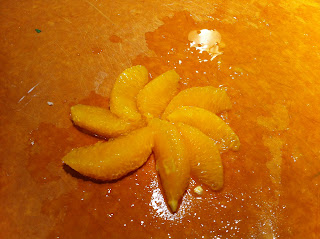Today Jesse and I took the fundamental knife skills class offered at Sur La Table. The course description stated that they would be teaching and allow the practicing of fundamental cuts for vegetables--mince, dice brunoise, batonnet and julienne--as well as some advanced techniques.
Just like our date night class, this one was set up for 16 people. Again it was a bit tight and cramped, but at least we all recieved out own equipment to use. Each student was presented with an 8 inch chef's knife, a paring knife, a composite cutting board, a bar mop, a bench scraper and an apron.
For the main cutlery we'd be using, you were either given a European style chef's knife, in my case, the Zwilling J.A. Henckels Profection 8-Inch Chef Knife


The difference between the two come down to weight, thickness and blade angle, with the Japanese knife being lighter, thinner and having an acuter angle. I really didn't like the Henckels, at least not this model, but I was still able to complete all the cuts with it.
The instructor guided us through varying sizes of dices and juliennes on a bell pepper, celery, carrot, potato and an onion. She also provided some tips on how to best approach these cuts on each vegetable, which really helped in performing the cuts.
 |
| Carrot - julienne, medium dice, small dice and brunoise |
 |
| Onion - julienne and diced |
Want to garnish your dished with some basil or another leafy herb? Just roll them up horizontally like a cigar, then slice off sections like you would a carrot and when they unroll, you got yourself a chiffonade.
To end the class, we learned how to supreme a citrus fruit. Basically, the goal is to produce an attractive, skinless citrus section without the rind or the pith (the white stuff in an orange or other similar citrus fruit). I've always wondered how people do that, I just thought there was some super secret orange peeling technique I never heard of.
Unlike the cooking class, I really enjoyed this 2-hour hands-on class. It was worth being able to just slice and dice away without any care while the instructors would constantly come around and check how you were doing and clean your cutting board of the results of your practice. I would recommend this class to to anyone who wants to learn the proper way to use a chef's knife in the kitchen. I will now leave you with my opinion on kitchen knives until I buy my own set.
1. A sharp knife is MUCH more useful and efficient that what you have in your kitchen
2. Not everyone will like the same knife
3. Expect to pay over $100 for a good chef's knife
4. The french have a name for EVERYTHING
5. A sharp knife is REALLY sharp
-Naris




I really like these skills how to used knife.Nice blog share with us.
ReplyDeleteOut Of Front Knives